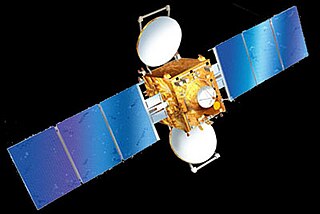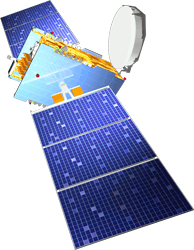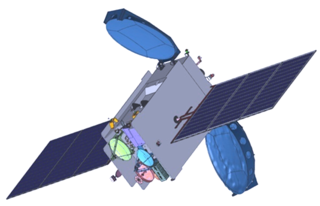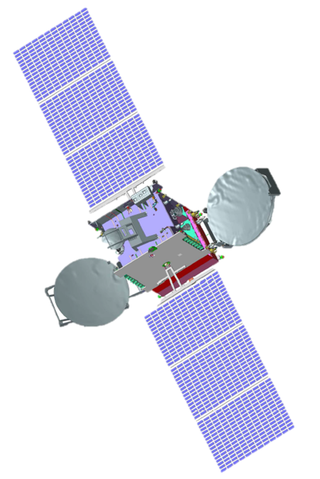
The Indian National Satellite System or INSAT, is a series of multipurpose geostationary satellites launched by ISRO to satisfy the telecommunications, broadcasting, meteorology, and search and rescue operations. Commissioned in 1983, INSAT is the largest domestic communication system in the Indo-Pacific Region. It is a joint venture of the Department of Space, Department of Telecommunications, India Meteorological Department, All India Radio and Doordarshan. The overall coordination and management of INSAT system rests with the Secretary-level INSAT Coordination Committee.
The GPS-aided GEO augmented navigation (GAGAN) is an implementation of a regional satellite-based augmentation system (SBAS) by the Government of India. It is a system to improve the accuracy of a GNSS receiver by providing reference signals. The Airports Authority of India (AAI)'s efforts towards implementation of operational SBAS can be viewed as the first step towards introduction of modern communication, navigation and surveillance / air traffic management system over the Indian airspace.

GSAT-4, also known as HealthSat, was an experimental communication and navigation satellite launched in April 2010 by the Indian Space Research Organisation on the maiden flight of the Geosynchronous Satellite Launch Vehicle Mk.II rocket. It failed to reach orbit after the rocket's third stage malfunctioned. The third stage was the first Indian-built cryogenic-fuelled upper stage, and was making its first flight. The ISRO suspects that the failure was caused by the third stage not igniting.

The Master Control Facility (MCF) is a facility set up by the Indian Space Research Organisation (ISRO) in the city of Hassan in the Indian state of Karnataka. Established in 1982, this facility is responsible for monitoring and controlling geostationary and geosynchronous satellites launched by ISRO. This was the only Master Control Facility of ISRO till another one was established in Bhopal in 2005.

INSAT 3E is a defunct communication satellite built by Indian Space Research Organisation. It was launched on September 28, 2003, from the European Space Agency's spaceport in French Guiana on board the Ariane rocket. The satellite had a launch mass of 2750 kilograms. It is the 4th satellite launched in the INSAT-3 series for INSAT. It was designed for providing high-speed communication, Television, VSAT & Tele-education services and was an important landmark in Indian Space Programme.

INSAT-4A was the first one in the INSAT-4 Satellites series, providing services in the Ku and C band frequency bands. At the time of launch, it was the heaviest satellite India had produced. The Ku transponders cover the Indian main land and C-Band transponders cover an extended area. It has a dozen Ku transponders and another dozen of C-band transponders. This spacecraft was placed at 83°E along with INSAT-2E and INSAT-3B, by Ariane launch vehicle (ARIANE5-V169).

GSAT-8 or INSAT-4G is communication satellite. It was constructed by the Indian Space Research Organisation, as part of INSAT system. GSAT-8 was launched on May 21, 2011, from Kourou, French Guiana. The rocket, an Ariane 5 was the carrier, marketed by the European Arianespace. First satellite to carry GAGAN payload followed up by GSAT-10 and in-orbit spare GSAT-15.

GSAT-11 is an Indian geostationary communications satellite. The 5854 kg satellite is based on the new I-6K Bus and carry 40 transponders in the Ku-band and Ka-band frequencies, which are capable of providing up to 16 Gbit/s throughput. GSAT-11 is India's heaviest satellite.
GSAT-7 or INSAT-4F is a multi-band military communications satellite developed by the Indian Space Research Organisation. The Indian Navy is the user of the multi-band communication spacecraft, which has been operational since September 2013. According to defense experts, the satellite will enable the navy to extend its blue water capabilities and stop relying on foreign satellites like Inmarsat, which provide communication services to its ships.
GSAT-15 is an Indian communication satellite similar to GSAT-10 to augment the capacity of transponders to provide more bandwidth for Direct-to-Home television and VSAT services. It was successfully launched on 10 November 2015 at 21:34:07 UTC aboard an Ariane 5 rocket, along with the ArabSat 6B satellite.
GSAT-16 is the 11th Indian communication satellite, meant to increase the number of transponders available for satellite-based telecommunication, television, and VSAT services in India. GSAT-16 is similar to GSAT-15 with each satellite weighing 3,150 kg and having power generation capacity of 6.8 kW.
INSAT-4B was an Indian communications satellite which forms part of the Indian National Satellite System. Launched in 2007, it was placed in geostationary orbit at a longitude of 93.48° East.
IRNSS-1E is the fifth out of seven in the Indian Regional Navigational Satellite System (IRNSS) series of satellites after IRNSS-1A, IRNSS-1B, IRNSS-1C and IRNSS-1D. It is one among the seven of the IRNSS constellation of satellites launched to provide navigational services to the region. The satellite was placed in geosynchronous orbit. IRNSS-1E has been successfully launched into orbit on 20 January 2016

IRNSS-1F is the sixth navigation satellite out of seven in the Indian Regional Navigational Satellite System (IRNSS) series of satellites after IRNSS-1A, IRNSS-1B, IRNSS-1C, IRNSS-1D and IRNSS-1E. The satellite is one among the seven of the IRNSS constellation of satellites launched to provide navigational services to the region.

GSAT-17 is an Indian communications satellite. Built by ISRO and operated by INSAT, it carries 24 C-band, 2 lower C-band, 12 upper C-band, 2 CxS, and 1 SxC transponders. It additionally carries a dedicated transponder for data relay (DRT) and search-and-rescue (SAR) services. At the time of launch, GSAT-17 was the heaviest satellite built by ISRO.

GSAT-18 is an Indian communications satellite. Built by ISRO and operated by INSAT, it carries 24 C-band, 12 extended C-band, and 12 Ku-band transponders.

GSAT-29 is a high-throughput communication satellite developed by the Indian Space Research Organisation (ISRO). The mission aims at providing high-speed bandwidth to Village Resource Centres (VRC) in rural areas. The two Ku and Ka operational payloads will provide communication services to Jammu and Kashmir and Northeast India under Digital India programme. At the time of launch GSAT-29 was the heaviest satellite, weighing 3,423 kg (7,546 lb), that was placed in orbit by an Indian launch vehicle. Approved cost of GSAT-29 is ₹175.63 crore (US$22 million).

GSAT-30 is a telecommunications satellite developed by the Indian Space Research Organisation (ISRO).
INSAT-2D was an Indian communications satellite. Launched on 4 June 1997, and similar to INSAT-2C, INSAT-2D went out of order on October 4, 1997, because of a power inconsistency problem and was later replaced by INSAT-2DT, an in-orbit satellite which was previously known as ARABSAT-1C. The main aim of the satellite was improved communication. In the INSAT-2 series, INSAT-2D was the fourth consecutive communication satellite. The satellite was launched using an Ariane 4 rocket from French Guiana.
CMS-02 is an Indian Communication Satellite built by ISRO. The CMS-02 satellite is funded, owned and operated by New Space India Limited. Cost of spacecraft was around ₹400 crore. The entire capacity onboard CMS-02 satellite will be leased to Tata Play. The satellite was placed into orbit by using Ariane 5 rocket.











